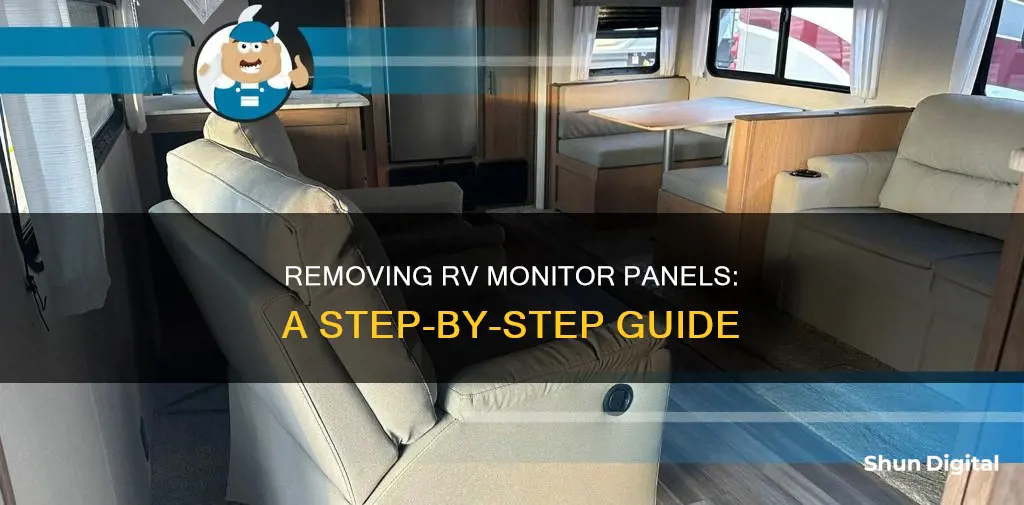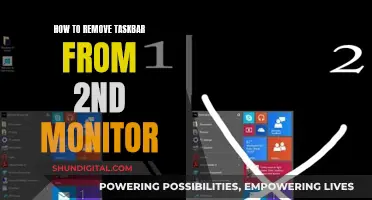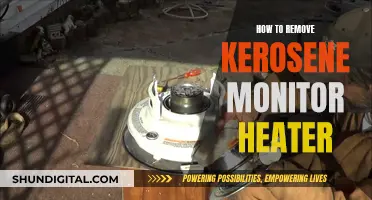
If you're looking to remove your RV monitor panel, it's likely that you're experiencing some issues with it. RV monitor panels are a great way to keep track of your vehicle's specifications, such as water tank levels, battery voltage, and other important functions. However, they can sometimes malfunction due to wiring issues, faulty fuses, dead batteries, or configuration errors. Before removing your RV monitor panel, it's a good idea to try some troubleshooting steps to identify and fix the problem. You can check the wiring, fuses, battery, and connections for any issues. If the problem persists, you may need to replace the entire panel, which is a relatively easy process. It's important to follow the safety guidelines and seek professional help if you're unsure about any part of the process.
| Characteristics | Values |
|---|---|
| Why remove the RV monitor panel | The monitor panel may not be working due to a blown fuse, wiring issues, a dead battery, configuration errors, or dirty connections. |
| When to call a professional | If none of the solutions fix the problem, an experienced technician can diagnose the issue and provide the necessary repairs. |
| Tools required | Needle-nose pliers, wire strippers and crimpers, electrical tape or shrink wrap tubing, a heat gun, a voltmeter or multimeter, and a variety of screwdrivers. |
| Steps to replace a wire | 1. Turn off all electrical power. 2. Remove the RV monitor panel cover and locate the wire that needs to be replaced. 3. Disconnect the broken wire. 4. Measure, cut, and strip the new wire. 5. Connect the new wire to the appropriate terminals. 6. Turn the power back on and test. |
| Steps to replace a fuse | 1. Locate and identify the affected fuse. 2. Make sure the power switch is off. 3. Unscrew and remove the fuse. 4. Install a new fuse of the same amperage. 5. Turn on the power switch and test the monitor panel. |
| Steps to reset the RV monitor panel | 1. Turn off the power to the monitor panel. 2. Unplug or disconnect all cables and wires. 3. Wait for at least 10 minutes. 4. Reconnect the cables and wires. 5. Turn on the power and ensure all switches are in their default positions. 6. Test the monitor panel. |
What You'll Learn

Check for wiring issues
When checking for wiring issues in your RV monitor panel, it is important to be confident in what you are doing. If you don't feel sure, it is much safer to wait until you have all the information or help you need.
If you are happy to proceed, the first step is to turn off all electrical power going through the RV by unplugging any shoreline power plugs and turning off all circuit breakers. You should then remove the RV monitor panel cover and locate the wires.
Check the wires for any signs of wear or damage, such as fraying or loose connections. If you detect a problem, replace the wire as soon as possible to avoid further electrical damage. Check areas where wires may be exposed to movement or the elements, such as near slides or underneath the RV.
If you suspect that a wire is broken, you will need to replace it. To do this, disconnect the wire from both ends, being careful not to damage any other wires in the area. Measure the length of your new wire, cut it, strip both ends, and connect them to the appropriate terminals, following your RV's wiring diagram as a guide.
Understanding UserMode on Your ASUS Monitor
You may want to see also

Check for a blown fuse
If your RV monitor panel is not working, a blown fuse could be the culprit. Fuses are an important safety feature in your RV's electrical system, interrupting a faulty flow of electricity and preventing a dangerous current overflow. When a fuse blows, it will look burnt or discoloured, with a dark or discoloured band across the middle.
To check for a blown fuse, first, locate your fuse box. In an RV, this is usually found in the electrical compartment, which could be in a closet, cabinet, or behind a panel on a wall or underneath a seat. Your RV will likely have both a fuse box and a circuit breaker panel located next to each other.
Once you've found the fuse box, open it up and look for any tripped breakers. If you find any, simply flip them back on. If this fixes the problem, you're done! If not, it's time to inspect the fuses. Look for a fuse that appears burnt or discoloured, or read the labelled diagram to identify which fuse corresponds to the appliance that isn't working.
To confirm that a fuse is blown, you can test it with a test light or a multimeter. First, ground the test light by clamping its alligator clip onto a screw on the fuse box. Then, touch the test light probe to each side of the fuse. If the light doesn't turn on for one or both sides, the fuse is blown and needs to be replaced.
With a multimeter, set it to the "ohm" setting and touch one lead to one end of the fuse legs and the other lead to the other end. If the reading is low (e.g., "0.2"), the fuse is good. If the reading is "OL" (out of limits), the fuse is blown.
If you've confirmed that a fuse is blown, be sure to replace it with a new fuse of the same amperage rating. Always turn off and unplug the electrical appliance corresponding to the fuse before removing the old fuse and inserting the new one.
Troubleshooting TCP Port Monitor 1801 Unavailability
You may want to see also

Check the battery
Checking your RV's battery is a crucial step in ensuring your vehicle is safe to operate and preventing any potential issues while on the road. Here are some detailed instructions on how to check your RV battery:
Inspect the Battery Casing:
Start by examining the physical condition of the battery. Look for any signs of damage, such as bulging, discolouration, or cracks on the plastic casing. If you notice any of these issues, it is recommended to replace the battery as there might be something internally wrong. A damaged battery can leak corrosive sulfuric acid, which can cause further problems.
Check Terminal Connectors:
Ensure that the terminal connectors are tight and free from corrosion. If you spot any corrosion, carefully remove the wiring and clean the battery posts and wire connector lugs. You can use a wire brush or a mixture of baking soda and water for this task. Commercial terminal battery cleaners and sprays are also available. To prevent future corrosion, apply a thin layer of dielectric grease or similar products (e.g., Fluid Film or Vaseline) to the exposed metal connector surfaces.
Check Battery Fluid Levels:
Battery fluid levels are often overlooked, but they are crucial for maintaining battery performance. Over time, batteries can lose fluid through outgassing. Check the battery fluid levels by removing the removable caps on the battery top. Use a flashlight to peek down the holes and locate the lead plates. The fluid level should be above the lead plates and about an eighth of an inch (approximately one inch from the battery top) to prevent damage and allow for expansion.
Top Up Battery Fluid:
If the fluid level is low, use mineral-free distilled water to top it up. A turkey baster can be a precise tool for this task. Be cautious when handling battery fluids, and always have a mixture of baking soda and water nearby to neutralize any spills.
Test the Battery:
You can test your RV battery in two ways: with a digital voltmeter or a hydrometer. Before performing these tests, ensure that the batteries are fully charged, disconnected, and allowed to sit for several hours. Then, connect them to a load and run for a few minutes to remove any surface charge.
A. Digital Voltmeter Test:
Connect the red wire of the voltmeter to the positive terminal and the black wire to the negative terminal of the battery. A fully charged 12-volt battery should read around 12.6–12.8 volts, while a 6-volt battery would be half of that.
B. Hydrometer Test:
The hydrometer test involves checking the specific gravity of the battery fluid to determine if the mix of sulfuric acid and water is correct. Carefully remove the battery filler caps and dip the hydrometer into the fluid, sucking up a test sample. The hydrometer will have a series of lines and graphs that indicate the charge level. This test is messier and more dangerous due to the highly corrosive nature of battery fluids.
Tips for Working with Lead-Acid Batteries:
When working with lead-acid batteries, it is essential to prioritise safety:
- Wear disposable rubber gloves and old clothes to protect your skin from the corrosive acid.
- Remove jewellery and wear eye protection to shield your eyes from potential splashes.
- Keep a fresh water source nearby to quickly flush acid from skin or eyes in case of accidental contact.
- Always neutralise battery acid spills with a baking soda and water mixture.
Theatre Mode: ASUS Monitor's Unique Feature Explained
You may want to see also

Check for dirty connections
Dirty connections can cause a lot of problems with your RV monitor panel, and it's important to check for these issues before assuming you need to replace the entire panel. Here are some detailed steps to help you check for and address dirty connections:
Check the Wiring
The first thing to do when your RV monitor panel is not working is to check the wiring. Sometimes, the current coming to the panel can be disrupted due to fluctuations or damaged wiring. It is recommended to ask a professional to check the wiring to ensure your safety. However, if you want to check it yourself, use a voltmeter to take readings. If there is no power, there might be a problem with the backend or the wiring may need to be replaced. Confirm this by connecting the monitor panel to another power source.
Check the Battery
Another potential cause of issues with your RV monitor panel could be a dirty battery. Sometimes, the battery can get covered in dirt or grime, which prevents the current from flowing through it effectively. To clean the battery, use warm water and a soft brush to scrub the connectors gently. Also, check the water level on your batteries and fill them up if they are running low.
Check the Sensors
The sensors used by RV monitor panels are very sensitive, and dirt in your tanks can interfere with their readings. To address this, clean your tanks with mild soap and warm water, and ensure they are filled with mineral water. Then, remove the sensors and reinstall them in the positions suggested by the manufacturer. This should help you get accurate readings again.
Adjust Sensitivity
If you are still experiencing issues with inaccurate readings, the problem could be that the sensitivity of the panel's readings is not calibrated correctly. Your panel likely has an option to adjust the sensitivity, so go into the settings and match the sensitivity to your tank's specifications. This should help you get more accurate readings.
Blue Light and LCD Monitors: What's the Truth?
You may want to see also

Check for configuration errors
When removing an RV monitor panel, it is important to check for configuration errors. Configuration errors can cause the monitor panel to display errors or not function properly. To check for configuration errors, you should consult the RV's manual to verify that all settings are correct. This includes checking for any changes that may have been made to the system, such as adjusting display settings or enabling certain features. If there have been any changes, reset the settings to their default or correct values.
In addition to checking the settings, you should also inspect the physical connections of the monitor panel. Ensure that all cables and wires are securely connected to the monitor panel and the corresponding components, such as the water tanks and propane tank. Incorrect or loose connections can lead to configuration errors and impact the monitor panel's functionality.
If you encounter issues with the monitor panel's readings, calibration may be necessary. Calibration involves adjusting the screws above each tank to fine-tune the readings. This process is important to ensure accurate measurements of the tank levels. The calibration procedure can vary depending on the type of tank, such as freshwater, greywater, or blackwater tanks.
By following these steps and referring to the RV's manual, you can effectively check for and address configuration errors when removing or working with an RV monitor panel.
Are My Text Messages Being Monitored? Signs to Look For
You may want to see also
Frequently asked questions
First, make sure to disconnect the power supply to the RV monitor panel. Then, remove all the wires and cables connected to the panel. You can then proceed to unscrew and take out the panel.
You will need a variety of screwdrivers, wire strippers, and a voltmeter or multimeter to test connections.
Check the wiring and fuses, as well as the battery. You can also try resetting the panel by disconnecting all cables and wires, waiting 10 minutes, and then reconnecting them.
Use a multimeter to test for continuity between each wire connected to the monitor panel. If any wires test open, there is a problem with the wiring. You can also check for a short between the ground and positive terminals.
Common causes include house battery issues, electrical wiring problems, configuration errors, and dirty connections.







